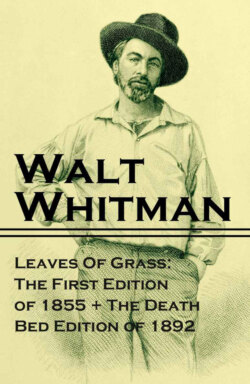Читать книгу Leaves Of Grass: The First Edition of 1855 + The Death Bed Edition of 1892 - Walt Whitman - Страница 3
На сайте Литреса книга снята с продажи.
LEAVES OF GRASS, 1855
ОглавлениеAlthough this poetry collection was first published in 1855, when Whitman was 36 years old, the poet spent his whole life revising the poems in several editions. Leaves and Grass is noteworthy for its depiction of sensual experience, which at the time of publication was considered immoral by many critics. Influenced by Ralph Waldo Emerson and the Transcendentalist movement, Whitman’s poetry praised nature and the individual human’s role within it. The title is a pun, with ‘Grass’ being a term given by publishers to works of minor value and ‘leaves’ being another name for the pages on which they were printed.
The first edition was published in Brooklyn at the Fulton Street printing shop of two Scottish immigrants, James and Andrew Rome, whom Whitman had known since the early1840s. Whitman financed and completed the typesetting for the first edition himself. The collection did not bear the poet’s name, instead offering an engraving by Samuel Hollyer depicting the poet in work clothes and a jaunty hat, with arms at his side. The book itself was very small, collecting only twelve unnamed poems in 95 pages. Whitman had once said he intended the book to be small enough to be carried in a pocket, which, would “induce people to take me along with them and read me in the open air: I am nearly always successful with the reader in the open air.” About 800 books were printed, though only 200 were bound in its trademark green cloth cover.
By the time the last edition was completed at the end of Whitman’s life, Leaves of Grass had grown from a small book of 12 poems to a large tome of almost 400 works. As the volume changed, so did the pictures used by Whitman to illustrate them, with the last edition depicting him as an old man with a full beard and jacket, with a wise and distinguished persona.
To give our readers an insight into the poet’s development, the 1855 first edition is included in this eBook, followed by the Inclusive Edition, based on the last version revised by the poet.
